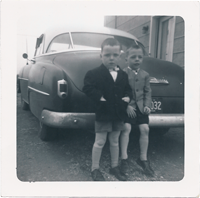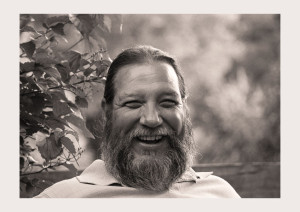A portrait of: Mark McNamara (b.1955, Fort Atkinson, WI – d. )
Mark McNamara is the great-great-great- grandson of Michael & Biddy Fagan. This branch of the Fagan clan has lived in southeastern Wisconsin for four generations ever since Mark’s adventurous great grandfather, Leonard Fagan (b.1889 – d.1962) and his brother, Mark’s great-great uncle, Liam Fagan (b.1887 – d.1962) left their sooty steel mill neighborhood in South Chicago to make their place in the world – finding it in the green rolling hills of the Dairy State in 1909. The young, entrepreneurial brothers, Liam and Leo, seized on a business opportunity in Benson’s Corner, Wisconsin, a railroad intersection town halfway between Milwaukee and Madison. They gambled what little money they had on the purchase of a defunct lumber mill on the banks of the Kickapoo River.

Leonard Fagan and Liam Fagan with their sister brides Nadine and Claudine Smith taken 1910
The mill was once profitable but went out of business when the area was stripped of its timber decades before. The savvy brothers realized that the local stands of softwood, especially birch, quaking aspen, alder, and willow had flourished after the prized building lumber – white pine, red cedar, maple and tamarack – had been cleared. The ingenious brothers trapped dozens of beaver throughout the hilly terrain from the Walworth County line to the Sheboygan Marsh, and relocated them along the Vermillion and Kickapoo Rivers near Benson’s Corner. The softwood trees, a favorite among beavers, were quickly felled for their dam building, which flooded the surrounding marshland and pock-marked landscape. The brothers managed the beaver colonies, and the natural water retention project became a practical solution to the recurring flood control problems caused by the deforestation, which had plagued the Milwaukee River Valley to the east. The City of Milwaukee was particularly grateful to have saved millions of dollars in infrastructure and flood control costs through the brothers’ innovative conservation techniques. At the same time, it transformed the innavigable Kickapoo River and provided a cheap and efficient way for the brothers to get trainloads of 16-foot logs from Michigan’s Upper Peninsula offloaded at a railroad siding west of Benson’s Corner. Then they floated them down river directly to the mill, which was also powered by the current from the rise in water level, compliments of the beavers.
The handsome brothers, not yet 25 years old, gained notoriety for their efforts, and their success and celebrity enabled them to purchase 160 acres of land adjacent to the mill at the astonishing sum of $110.00 an acre. They discovered a mineral spring on their property and immediately set to the task of building an elaborate “lodge” over the spring. Getting building materials certainly wasn’t a problem. They now owned and operated the largest lumber mill in the county, and the surrounding countryside was comprised of an abundance of sand, gravel, and boulders.
When the brothers completed their mineral spring project they named it L.L. Fagan’s Medicinal Sanitarium. A local advertisement from the time boasted that it contained “curative waters for all matter of ailments.” Another endorsement in Volume 36 of Bayer Brother’s Druggists Monthly in 1913 touted “L.L Fagan’s Medicinal Sanitarium provides you a place to abide whether in your declining years or when friends and health forsake you. No more ideal place to vacation can be found than Benson’s Corner.” The area was nationally known among tourists in the early part of the century who sought the medicinal and therapeutic relief the local waters were said to provide.
The Fagan brothers did everything together. They worked hard, they played hard, and they drank hard. The people of Benson’s Corner used to joke that if you wanted to know where one was, all you had to do is find the other. The brothers even married twin sisters from Mukwonago, Nadine and Claudine Smith, who were as energetic and resourceful as their husbands and worked diligently to keep the various family enterprises going strong. The Fagans’ success led to annual expansions to the lodge, which the brothers filled with an odd collection of stuffed wild animals and fish that they had hunted, trapped, hooked, preserved, and mounted themselves. They also operated a restaurant, a rustic hotel, and several log cabins along the Kickapoo River.
When the brothers were installing a drain tile near a bog on the east end of their property in 1921, they unearthed the bones of a Pleistocene mastodon. Knowing nothing about archeological excavation didn’t deter them. They recovered nearly the entire skeletal specimen, tusks and all, and reassembled the giant pachyderm in the lobby of their hotel after knocking the roof off and adding a two-story atrium to accommodate the beast. It became a huge tourist attraction. By the early ‘20s the tireless and resourceful pair also opened a roller rink, a supper club, a filling station and an icehouse, cutting blocks of ice by hand from Upper Mineral Lake to keep themselves busy during the slow winter months when they weren’t hunting, trapping, or ice fishing. They then stored and delivered the blocks to local residents and businesses for refrigeration during the summer. They even pioneered an ingenious evaporative air conditioner system in their hotel utilizing blocks of ice they harvested the previous winter.

Mark McNamara and brother
Leonard & Nadine and Liam & Claudine each had huge families, 19 children between the two pair, all of whom were required to “help out” in one the many family businesses.

Mark McNamara
Most left Benson’s Corner when the resort went out of fashion and the property and the mill were purchased by the state in 1937 (for 10 times what the brother’s had paid for it) for the formation of Kettle Moraine State Park. Leo & Nadine’s oldest child, Vivian (Mark’s Grandmother) stayed in the area however, and married a local dentist, Arthur McNamara. Arthur and Vivian’s son, Sinclair, bought a house in town and took over one of his grandfather’s filling stations and auto repair businesses in 1949. Mark worked there with his father and two brothers until he took a job in 1977 at the GM truck assembly plant in Janesville. On weekends Mark plays guitar in a country-western band at supper clubs and local bars. His wife, “Trish” (Patricia Ray-Webb), is the lead singer.
On hot summer nights Mark and Trish have been known to ride their motorcycles up a service road, to a remote section of Kettle Moraine State Park. They hike up to a secluded and long forgotten pool spring that was once covered by his great grandfather’s lodge, and soak in its refreshing waters, and family memories.
Read More
Geomorphology: The study of landform
Palmyra, Wisconsin
Mastodons
Wisconsonian Glacier
Kettle Moraine State Park

